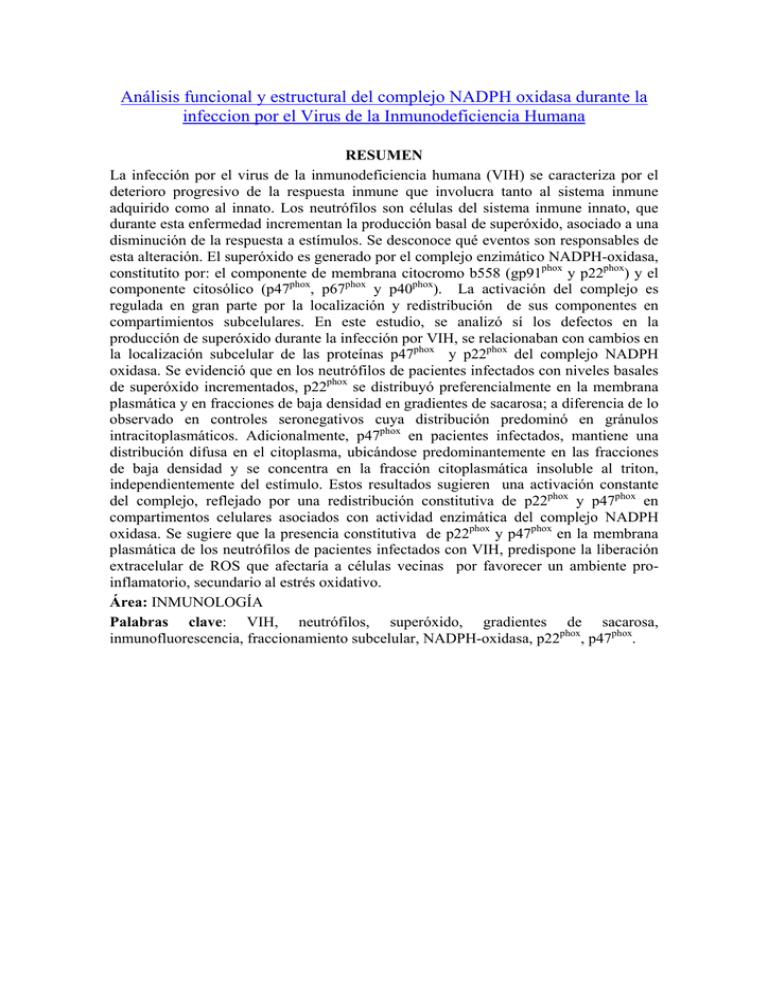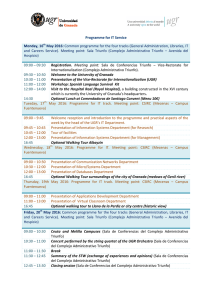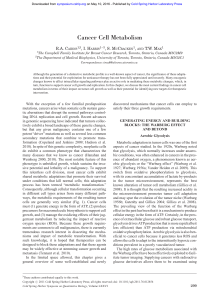Análisis funcional y estructural del complejo NADPH- oxidasa
Anuncio

Análisis funcional y estructural del complejo NADPH oxidasa durante la infeccion por el Virus de la Inmunodeficiencia Humana RESUMEN La infección por el virus de la inmunodeficiencia humana (VIH) se caracteriza por el deterioro progresivo de la respuesta inmune que involucra tanto al sistema inmune adquirido como al innato. Los neutrófilos son células del sistema inmune innato, que durante esta enfermedad incrementan la producción basal de superóxido, asociado a una disminución de la respuesta a estímulos. Se desconoce qué eventos son responsables de esta alteración. El superóxido es generado por el complejo enzimático NADPH-oxidasa, constitutito por: el componente de membrana citocromo b558 (gp91phox y p22phox) y el componente citosólico (p47phox, p67phox y p40phox). La activación del complejo es regulada en gran parte por la localización y redistribución de sus componentes en compartimientos subcelulares. En este estudio, se analizó sí los defectos en la producción de superóxido durante la infección por VIH, se relacionaban con cambios en la localización subcelular de las proteínas p47phox y p22phox del complejo NADPH oxidasa. Se evidenció que en los neutrófilos de pacientes infectados con niveles basales de superóxido incrementados, p22phox se distribuyó preferencialmente en la membrana plasmática y en fracciones de baja densidad en gradientes de sacarosa; a diferencia de lo observado en controles seronegativos cuya distribución predominó en gránulos intracitoplasmáticos. Adicionalmente, p47phox en pacientes infectados, mantiene una distribución difusa en el citoplasma, ubicándose predominantemente en las fracciones de baja densidad y se concentra en la fracción citoplasmática insoluble al triton, independientemente del estímulo. Estos resultados sugieren una activación constante del complejo, reflejado por una redistribución constitutiva de p22phox y p47phox en compartimentos celulares asociados con actividad enzimática del complejo NADPH oxidasa. Se sugiere que la presencia constitutiva de p22phox y p47phox en la membrana plasmática de los neutrófilos de pacientes infectados con VIH, predispone la liberación extracelular de ROS que afectaría a células vecinas por favorecer un ambiente proinflamatorio, secundario al estrés oxidativo. Área: INMUNOLOGÍA Palabras clave: VIH, neutrófilos, superóxido, gradientes de sacarosa, inmunofluorescencia, fraccionamiento subcelular, NADPH-oxidasa, p22phox, p47phox. SUMMARY Human immunodeficiency virus (HIV) infection is characterized by the progressive detriment of the immune response, associated to loss of key elements of the immune system, named T cell lymphocytes. Although these cells are the main target of the virus, a great deal of interest has recently emerged for other cellular components of the immune system, which are altered during the disease as well, contributing to disease progression. Polymorphonuclear (PMN) cells have been described as dysfunctional during the course of the disease showing an increased constitutive superoxide production making these cells refractory to stimulation. A major source of ROS production had been found to be a phagocyte-type NADPH oxidase. The neutrophil NADPH oxidase comprises a plasma membrane-bound cytochrome b558 (which is a heterodimer of one p22phox and one gp91phox subunit) and at least four cytosolic subunits, namely p47phox, p67phox and p40phox. During neutrophil activation in response to various agonists, the cytosolic subunits translocate to and associate with the cytochrome b558, a process that results in oxidase activation. Based on this, we hypotehezized that an altered assambly or traslocation of the NADPH oxidase components could be responsible for the disfuntion observed in neutrophil’s superoxide production during the course of the disease. A set of differente strategies were performed to prove our hyphotesis: immunofluorescence and confocal microscopy, subcellular fractionation and protein analysis by sacarose gradient sedimentation and western blot. The results indicate that neutrophils from HIV infected patients showed altered cellular distribution both in p22phox and p47phox, before cells were stimulated, in that p22phox was preferentially target to the plasma membrane and to low density fractions in sucrose gradient sedimentation (between 4S and 2S); conversely, the protein associates mainly to cytoplasmic granules in neutrophils from seronegative controls. Aditionally, p47phox from HIV positive patients showed a difuse cytoplasmic localization and was predominant in low-density sedimentation and detergent-insoluble fractions. These results suggest a constituvely localization of important components of the NADPH oxidase complex in neutrophils from HIV patients, in cellular compartments associated with activation and probably with the cytoskeleton that could explain the increased oxidative stress and the lack of response to further stimulation, observed during the course of the disease. These defects may be also associated to the decreased survival of neutrophils obeserved in advenced disease. Field: INMUNOLOGY. Keys word: HIV, superoxide, NADPH-oxidase, Nef, p22-phox, p47-phox, confocal microscopy, subcellular fractionation and sacarose gradient.


